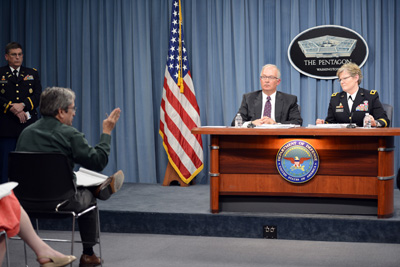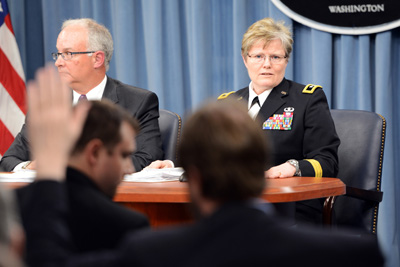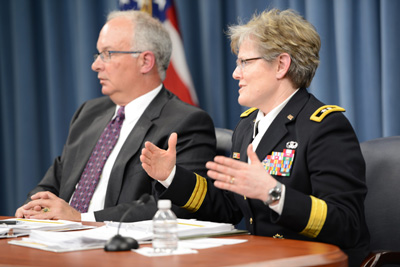By C. Todd Lopez
WASHINGTON (April 10, 2013) -- Soldiers will see a one percent pay raise in 2014. Their untaxed paycheck will also benefit from a 3.9 percent increase in basic allowance for housing and a 3.4 percent increase in basic allowance for subsistence as well.
The Army announced April 10 its fiscal year 2014 budget request, which amounts to $129.7 billion -- that's part of the president's $3.03 trillion total government budget request for the fiscal year, which begins Oct. 1, 2013.

During a briefing at the Pentagon, Maj. Gen. Karen E. Dyson, director of the Army Budget, and Davis S. Welch, deputy director of the Army Budget, discussed components of the Army's proposal, including how much is marked for supporting personnel, how much is marked for facilities maintenance, and how much will go toward buying or modernizing war-fighting equipment.
The new budget represents a continued adaptation to the Department of Defense's 2012 defense strategy, Dyson said.
"Adapting to the 2012 defense strategy means we are refocusing our training away from the emphasis that has been there on counter-insurgency -- [which] was so key and critical in the Iraq War and remains critical today in the war in Afghanistan -- and refocusing our training to go more toward core competencies, combined arms maneuver and wide area security."
Dyson also said the Army, despite fiscal difficulties, demonstrates in its budget proposal that it remains committed to those Soldiers currently involved in the war, those Soldiers who are preparing to go to war, Soldiers engaged in Korea or going to Korea, and Soldiers that are part of the Army's Global Response Force.
For other Soldiers, she said, there is a reduction in training dollars.
"We are starting to see readiness slipping away from some of those units," she said.
Noticeably absent from this year's budget briefing were numbers related to the "overseas contingency operations" budget -- which is separate from the Army's proposed "base budget." The base budget supports the training, equipping and sustaining of the "generating force," while the overseas contingency operations budget supports the war-fighting effort overseas and is usually presented at the same time, but as a separate request. Dyson said planning for the fiscal year 2014 overseas contingency operations is not yet complete.
This year's total fiscal year 2014 base budget for the Army comes to about $129.7 billion. Of that, about 44 percent, or $56.6 billion, is for military personnel; about 18 percent, or $23.9 billion is for procurement research, development, testing and engineering; and about 35 percent, or $45.5 billion, is for operations and maintenance. This year's base budget request is approximately $5 billion less than last year's request.
MILITARY PERSONNEL
This year's military personnel budget provides for Soldiers a one percent pay raise for 2014. It also increases basic allowance for housing by 3.9 percent, and increases basic allowance for subsistence by 3.4 percent, Dyson said. The budget also supports incentives for the all-volunteer force, to include recruiting and retention bonuses.
For the active Army, the budget asks for $41 billion, a slight increase over last year's request. The military personnel budget request for the Army Reserve also increased slightly to $4.5 billion, and the Army National Guard request went down -- coming in at $8 billion.
OPERATIONS AND MAINTENANCE
The O&M budget request this year took a cut of about $1.54 billion. It funds everything from 21 training center events in fiscal year 2014, to six mission command exercises and combatant commander engagement activities. The O&M budget also funds normal operations at 158 Army installations, family and Soldier programs and training miles and flying hours. The O&M budget also pays for the training of new Army recruits.
MODERNIZATION
"Our [fiscal year] 2014 president budget request demonstrates a cost-effective decision to modernize many of our existing platforms -- to maintain the technological edge over potential adversaries," said Welch. "Our approach integrates mature technologies and incremental improvements."

Welch told reporters that the current fiscal environment requires "smaller procurement objectives" for the Army.
"We cannot equip and sustain the entire force with the most advanced equipment," he said. But, "where capability gaps cannot be closed in modernization of existing platforms, new ones will be procured."
Critical modernization efforts include continued development of equipment designed to protect the Soldier, as well as development of the Army network.
The Army's network strategy sees about $1.8 billion in funding to provide continued support to technologies such as the Warfighter Information Network - Tactical, the Joint Tactical Radio System, the Joint Battlefield Command Platform, Nett Warrior and the Distributed Common Ground System - Army.
The Army network, Welch said, remains "critical to empowering our Soldiers and leaders with the right information at the right time, to make decisions essential for mission success."
This year, the fiscal year 2014 budget proposal requests funds meant to complete fielding of Increment 1 of WINT-T, for instance, and additionally supports fielding of Increment 1A, and Increment 2 -- the "limited on-the-move" capability.
Funding requests this year also support advancements in Nett Warrior, Welch said, which includes procurement of "tablet-like devices -- enabling squads uncommon situational awareness while dismounted."
Finally, Welch said, the fiscal year 2014 budget request funds two Network Integration Evaluations. "These exercises are critical as they integrate and validate the Army as fielding platforms, components and software that are interoperable," he said.
EQUIPMENT
The Army has in the fiscal year 2014 budget request about $15.9 billion marked for procurement of aircraft, missiles, ammunition, weapons and tracked vehicles. That's about $763 million less than last year's request.
The Stryker gets $395 million for modification to the vehicle, to include conversion of the flat-bottom version to the more safe "Double V-hull" version. Work on that program will be split between Anniston Army Depot, Ala., and the Lima Army Tank Plant, Ohio.
The Paladin Integrated Management modification, coming in at $250 million, brings the system into low-rate initial production for 18 Paladin Integrated Management self-propelled howitzers which will go into brigade combat teams.
Additionally, Welch said, the funding for the M1A2 Abrams, at about $178 million, completes fielding to the Army National Guard of M1A2 Abrams "System Enhancement Package" tanks, and provides the Army with the two-variant Abrams fleet it was looking for.
Welch also said funding for the Bradley Fighting Vehicle program, about $158 million, kicks off an "engineering change proposal" that will restore to the vehicle size, weight, and cooling capabilities that had previously been "traded" for the improved survivability and mobility needed during combat operations over the last 12 years.
AIRCRAFT

The OH-58 Kiowa Warrior program gets $184 million for cockpit and sensor upgrades, and recapitalization on the cockpit, fuselage and tail boom, Welch said. Upgrades will yield weight reductions through new heaters and "composite universal weapons pylons and weapons displays."
Welch said an earlier flight demonstration of possible replacements for the Kiowa Warrior -- part of the "Armed Aerial Scout" program -- did not provide a suitable candidate for militarizing existing commercial airframes. The Kiowa budget provides for continued upkeep of the airframe while deciding on further development of new Armed Aerial Scout.
This year, with $1 billion in funding, the CH-47 Chinook enters the second year of a multi-year procurement effort. The Army will get six new aircraft from that effort, as well as 22 re-manufactured aircraft. The aircraft is being modernized with common avionics, digital advanced flight controls, common missile warning systems, and increased endurance and reliability through vibration reduction in its components, he said.
Budget requests for the UH-60 Black Hawk program, to the tune of about $1.2 billion, will pay for 65 new airframes. Included in that are 41 UH-60M utility aircraft and 24 HH-60M medical aircraft.
The AH-64 Apache gets about $813 million in the fiscal year 2014 budget request. That will provide funding for 42 re-manufactured Block III aircraft that can provide network-centric capability and "level 4" unmanned aerial system control capability that provides "manned-unmanned teaming" between Apache pilots and the unmanned aerial system they can control from their cockpit.
The fiscal year 2014 budget also requests $518 million to equip two Army companies with the MQ-1 Gray Eagle unmanned aerial system.
FACILITIES
Welch said funding for facilities in the fiscal year 2014 budget request reflects "a return to the more historical spending levels."
About $2.3 billion is marked for military construction, Army family housing and Base Realignment and Closure in the fiscal year 2014 budget request -- about $1.2 billion less than last year.
Welch said funds will be used for, among other things, replacing aging facilities. Nearly $750 million is marked for training ranges, reserve readiness centers, and failing infrastructure replacement. Facilities funding will also be used, he said, to support activation of the 13th Combat Aviation Brigade at Fort Carson, Colo., and the 16th CAB at Joint Base Lewis-McChord, Wash., and Fort Wainwright, Alaska.
GUNS
It's not all aircraft and ground vehicles in the fiscal year 2014 budget request -- there are also things Soldiers can shoot.
The "Integrated Air Burst Weapon System Family," also called the XM25 -- and at one time called "the Punisher" by Soldiers in Afghanistan -- is a counter-defilade target engagement system.
The XM25 was "tested and proven in Afghanistan against defilade targets, and the system provides dramatic increases in range and lethality compared to other individually fired weapons," Welch said. The system will get $69 million in fiscal year 2014 to enter low-rate initial production for as many at 1,424 of the weapons.
On a smaller scale, the Army's carbine program gets $71 million for 12,000 M4A1 carbines, and 29,897 Individual Carbines.